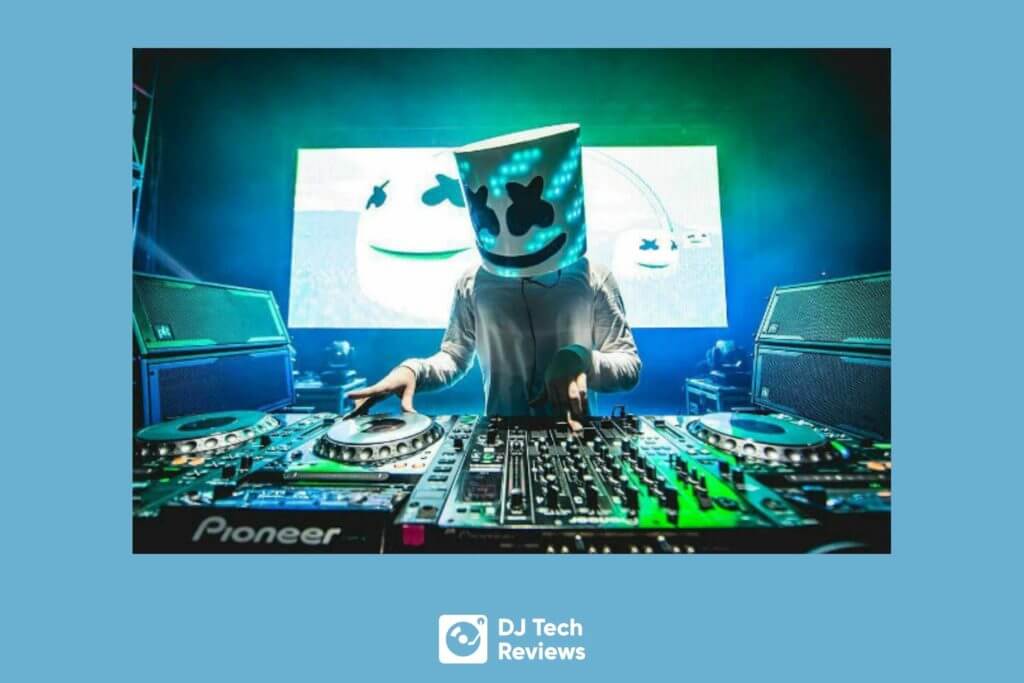If you’re someone who is just getting into electronic music, I hate to say it, but you’re kind of late to the party. But that is totally cool. Beyond cool!
The good news is that, unless you’re over 40, you’re in good company. Electronic dance music has been hitting the airwaves for well over 40 years now, creating a myriad of different sub-genres as a result.
The vast majority of DJ genres, like Techno, House, and Trance all owe their creation to the advent, growth, and mass popularization of electronic music.
We often talk about many of the different sub-genres of dance music, including House, Deep House, and Techno, but today we are focussing on EDM.
Short for “Electronic Dance Music”, EDM is not a particularly difficult genre of music to DJ and perform.
And because of its incredibly bass-heavy and high-energy nature, it’s one of the easiest.
In this overview, we’ll go over some of the best ways for you to DJ using EDM music. We’ll go over what equipment you’ll need, where you can get your music from, as well as some useful ways for you to develop your skills overall.
By the end of this article, not only should you have a firm understanding of how to perform using EDM, but you should also learn some important skills to improve yourself as a DJ overall.
How To Start EDM DJing? (in short)
There is no quick route to becoming a superstar EDM DJ but we do suggest you follow a simple formula. Involve yourself heavily in the scene, network at as many places as possible, master the core DJ skills, and, learn to produce killer tracks and develop a unique musical identity of your own. And lastly, you guessed it, practice, practice, practice!

Read this next: How To Become A Female DJ (11 Tips for Disc Jockey Girl Power)
How to Become an EDM DJ: The Basic Formula
As mentioned above, when it comes to DJing, EDM is one of the easiest genres of music to master.
Unlike House, Deep House, Funk, Trance, or Hip-Hop music, EDM relies on tracks that have a lot of fast-paced and high-intensity energy while also leveraging itself with a strong bassline.
This ensures most tracks are going to have a BPM that is at least somewhat compatible with one another, making beat matching and mixing considerably much more predictable.
There are several ways to best learn how to DJ EDM.
Below, we’ve broken these down into a simple, easy, step-by-step process that you can get started on pretty much right away.
Step #1. Get involved in the EDM Community
The first thing, if you want to learn EDM, is to immerse yourself in EDM culture. That means regularly listening to EDM performers and their tracks on your iPhone or another listening device.
It also means going to as many EDM parties, festivals, clubs, and events as possible.
Keep in mind that, rather than listening to the music just to listen to it, or going to the event just to enjoy the event, you’re there to learn as much as you can about how the music is played.
You want to listen intently to the different mixes and tracks that are being used. Not only will you be able to better understand how to construct your DJ set, but, by looking around and observing everyone, you’ll be able to know how to get the crowd hyped and on their feet.
Step #2. Study Other EDM DJs
This is kind of a follow-up to the previous point, but to a further extent.
Whereas Step 1 required you to simply immerse yourself in the culture, listening to any and everything EDM.
Step 2 goes a bit beyond this.
Here, you’re finding real EDM DJs and watching how they perform.
You’ll want to get as close to them as possible so that you can better see what type of equipment they’re using, how they are using it, as well as how they can control the audience and crowd at large.
In addition to seeing how they perform and how they can get the crowd moving, studying EDM DJs is also a great way to stay on top of any new types of music.
Generally, performing DJs are always going to have a finger on the pulse of the newest music. As a result, you can also build up an impressively extensive collection of tracks in addition to learning some useful DJ skills and techniques.
Step #3. Record and Playback Mixes
Lastly, don’t just spend your time theoretically learning this information. You want to get in there and actually what you’ve been taking in from others too!
While getting immersed in EDM and learning from other DJs is certainly useful, it’s only going to be by ‘getting your hands dirty’ and doing it yourself!
That way you’ll be able to see exactly how to manage an EDM track compared to other genres
And if you actually enjoy playing EDM. That’s kind of important, huh!
The good news is that, just because you’re recording yourself and your practice sessions doesn’t mean anyone else has to hear them.
Unless you’re really good right out of the gate, these recordings are meant solely to help you improve your skills.
Remember when I said that you should immerse yourself in the music, not to enjoy it personally, but to learn how certain methods were used?
Well, this is the same thing.
You’re only recording your music so you can see what you did right and what you did wrong.

Read this next: How Do DJs Interact With Crowds? (How to Read and Work a Crowd)
EDM DJ Gear You Need
Now that you understand some of the key steps you’ll need to get a firm grasp on playing with the EDM genre, we’ll now get into some of the things you’ll need as far as equipment is concerned.
This will include the right hardware, software, accessories, and speaker setup.
Hardware Options
First thing’s first, you’re going to need to get yourself some quality hardware for your setup. This is going to mean getting hold of a solid DJ laptop, DJ controller, or mixer & CDJ combination setup.
DJ Laptop
Ok, so this is a bit of a misnomer. Technically speaking, besides maybe the XMG DJ 15, there aren’t many laptops that are specifically designed for DJing up till this point.
Still, just because there aren’t many options out there that have been made specifically for DJs doesn’t there aren’t some laptops that make DJing easier than others.
Generally, you’re looking for a laptop that is both reliable as well as capable in terms of its processing power.
Simply put, you need something that can run most DJ software types reliably and without stuttering or crashing. Things like visual fidelity, charging, and even an excess of ports, while useful, should always be considered after you’ve got something sturdy and powerful.
Read this next: How To DJ With A Laptop In 3 Easy Steps
DJ Controller
After you’ve got yourself a good laptop, your next decision should be on whether you’ll opt for a DJ controller or a CDJ & mixer combo.
Without a doubt, those that are starting should make it a point of getting a DJ controller. Not only are they going to be less expensive (by a lot) than a mixer and two CDJs (more on that later), but it comes all-inclusive and often will come with software pre-installed and available for use.
If you decide on the DJ controller, you want to get the highest quality one you can afford. Generally, because of the varying price ranges, the cheaper you go, the lower quality you’re going to be dealing with.
The good news is that a controller in the $300-400+ range should be more than enough if you’re a beginner, so consider making that your initial bedrock if you can.
But saying that, there are also some great $100+ options that you can play around with whilst you are learning the ropes.
But pick wisely, you don’t want to end up with something poor. That will just put you off Djing from the off.
Also consider that, while many do come with DJ software options included, many don’t.
What’s more, if you get one that does come bundled with a software program, you’re probably going to be locked into that specific software type.
Read this next: Best DJ Controller for Beginners (Our Top 5)
CDJ & Mixer Setup
On the other hand, if you’ve decided to invest in a set of CDJs and mixers, while you can expect to pay more for your setup, you can rest in knowing that the quality is going to be higher overall as well.
I wouldn’t personally recommend anyone just getting started to jump into using CDJs over controllers.
However, if you decide to make that jump, you’ll want to make sure that you’re getting a quality mixer along with the CDJ options.
Generally, you don’t have to be quite as concerned with the quality of the mixer or the CDJ since even their cheapest options are still usually better than a good chunk of DJ controllers out there.
Like many DJ controllers, you’ll want to be aware that some CDJs can come with software already installed on them.
Unlike controllers, however, here you won’t need to use the CDJ in tandem with a laptop, instead only need the CDJ itself.
Read this next: CDJs vs DJ Controllers (Which Tech is Best?)

DJ Software Options
DJ software can be defined as a way to essentially make performing easier as a DJ.
These types of software allow you to better use your DJ controller more intuitively while not requiring you to run around using your keyboard, mouse, and laptop.
The most popular of these is one software known as Serato DJ. It comes with a ton of different and useful features that, while not required, make DJing much more accessible.
You don’t need to use any particular software when learning EDM (other options include, Virtual DJ, Pioneer DJ rekordbox, Traktor Pro by Native Instruments) so long as the program itself is good.
You also, when deciding on the software type that you use, want to take a look at what software is already being used on your controller or CDJ.
While you can technically still use a different type of software, they’re often optimized for their specific software type. That means you’ll get the most benefit from using what they have over any other option out there.
You can also try checking out their free options to see how you like any of them.
In most cases, the free option is just a restricted version of the paid one, meaning if you like the free version, you’ll love the full one.
Read this next: 8 Best DJ Software Options
Audio Setup Options
Lastly, if you plan to start DJing any type of music (not just EDM), you’ll need to set yourself up with a nice set of monitor speakers.
You’ll want to get a good set of over-ear headphones as well as some monitor speakers.
Headphones
Getting some good-quality headphones is very important as this will be what you use, both at your home set up as well as when you’re performing.
Quality over-ear headphones are used to help with track cueing ahead of what is heard through your speakers.
While you shouldn’t be spending a lot of money on some good DJ-based headphones, you should make sure that the sound quality is as clear as possible and that they are comfortable around your ears.
Read this next: 12 Best DJ Headphones – Top Picks for All Budgets
Monitor Speakers
It’s also important that you get yourself a good pair of monitor speakers. Since you can expect most venues and gigs you go to to have a set of speakers already, getting a moderately good set for your home is all you need.
These are great for practicing your performance and work to simulate the club-setting environment, meaning that you’ll want to spend more time getting the headphones over the studio monitors.

Read this next: Best DJ Speakers: Our Top Picks
Getting EDM Music
As mentioned earlier, you want to keep on top of the latest in EDM tracks for your DJ performance.
To do this, there are a lot of different websites and online locations you can go to specifically for EDM music.
Two of the most well-known providers include Beatport, Juno, and Traxsource. Not only do both of these options have a ton of files available for download, but they are also professionally put together and where the best of the best DJs usually go to get their music.
The downside to them, however, is that you have to purchase each track individually, which can get expensive.
To offset the potentially exorbitant cost of dealing with spending upwards of $1-2 per song (you’re going to need at least 15-20 songs to start and many more as you continue DJing), you can join a DJ record pool.
These allow you access to a large number of tracks while paying a relatively affordable monthly subscription.
It’s very similar to places like Spotify or SoundCloud, only the music is specifically designed for DJs.
Read this next: Which DJ Pool Is Best?
EDM DJ Tips & Tricks
Lastly, you want to learn to cultivate and develop your DJ skills to improve, not only in EDM but as a DJ overall.
While there are a variety of different courses and “how-to” videos online, as mentioned before, the best way to get better is by getting your hands dirty and playing around with it yourself.
Below are some useful tips for improving your skills as a DJ.
Tip #1. Practice, Understand and Master Your DJ Software
The first thing you’ll want to do is to get a firm grasp and understanding of your DJ software. You need to know what your software is capable of, and the best way to do that is by experimenting with it and seeing what tools you have available.
By “mastering” your software, you’re better able to familiarize yourself with whatever type of program you’re using.
This means that, when it’s time to perform, you’re not second-guessing yourself and whether a particular button does what you think it should do.
Tip #2. Beatmatching and Transitions
This is the most important aspect of DJing by far. You need to spend as much time learning how to
from one song to the next as smoothly and as seamlessly as possible.
To do this, focus on beatmatching the two tracks so that there isn’t a jarring jump when transitioning.
This means making sure that the tracks you use have as similar a beat, tempo, and rhythm as possible.
Tip #3. EQing
Lastly, you’ll want to spend a bit of time playing around and experimenting specifically with the EQ settings. EQing (or “equalizing”) is a great way to work on boosting or reducing certain specific musical tones.
This can result in sounds being vastly different based on how you’ve set the EQ, with an emphasis on the low-end bass giving a track a much deeper feeling as opposed to focusing on the treble.
As you’re starting, consider making slight and small changes to boost the sound.
Then, try changing them more and more so you can see just how different a track can sound based entirely on the way the EQ frequencies are altered.
Read this next: How to Beatmatch properly: The Ultimate Guide

How To Start EDM DJing?: Takeaway
We finish with our ‘How To Start EDM DJing’ takeaway.
The EDM genre, unlike any other type of music out there, was meant specifically for the DJing space.
Because of this, it has garnered a reputation for being very easy and accessible. And, while this is true, that doesn’t mean you shouldn’t take mastering it lightly.
By focusing on it, learning everything there is to learn about it, and strengthening your understanding of the genre overall, you ultimately open yourself up to a ton of other musical genres while also ensuring that you can perform in almost any mainstream club environment.
Read this next: Djing Guide (How To Start DJing from Your Bedroom)




